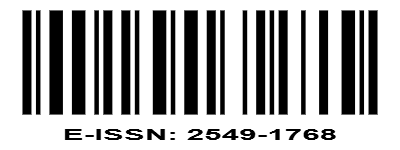APPLICATION OF PLANT BIOMASS COMPOST APPLICATION AND THE USE OF SEVERAL TYPES OF mulch ON THE GROWTH AND PRODUCTION OF RED ONION (allium ascalonicum L.)
DOI:
https://doi.org/10.22373/biotik.v10i2.12906Keywords:
Shallots, Types of Mulch, Dosage of Organic Fertilizer Plant WasteAbstract
Shallots are agricultural commodities that are always ordered, especially as a cooking spice. Without shallots, it feels as if there is something incomplete in the taste of the dish. To increase the production of shallots it is necessary to modify the cultivation. This study aims to determine the type of mulch and the dose of organic fertilizer from plant waste that has the best effect on the growth and production of shallot (Allium ascalonicum L). The research was carried out from April to July 2021 on the farmer's land, Jalan Sukarela Lr. Batujajar RT.18 KM 7 Sukarame Subdistrict, Palembang. This study used the Experimental Method with a Divided Plot Design consisting of 12 treatment combinations which were repeated 3 times to obtain 36 plots. Factor I = Mulch Type (M) consisting of 3 levels: M1 = Black Silver Plastic Organic Mulch, M2 = Water Hyacinth Organic Mulch, M3 = Jengkol Bark Organic Mulch. Factor II = Plant-waste Organic Fertilizer Dosage (L) consisting of 4 levels: L0 = Chemical Fertilizer According to Recommended Dosage, L1 = 5 tons/ha (1kg/plot), L2 = 10 tons/ha (2kg/plot) L3 = 15tons /ha (3kg/plot). The variables observed were plant height (cm), number of tubers per clump (tubers), tuber weight per plot (grams). The combination treatment of jengkol skin organic mulch with a dose of organic fertilizer from plant waste of 15 tons/ha (3kg/plot) gave the highest effect on the growth and production of shallots at 850.00 grams/plot or equivalent to 8.50 tons/ha.
Downloads
References
A. Kurnianingsih, Susilawati, and M. Sefrilla, “Prospek dan arah pengembangan agribisnis bawang merah,” Balitbangtan, vol. 9, no. 3, p. 1, 2006.
Badan Pusat Statistik Indonesia, Statistik tanaman sayuran dan buah-buahan semusim indonesia 2018. BPS-Statistics Indonesia, 2018.
M. Ansar, “Pertumbuhan dan hasil bawang merah pada keragaman ketinggian tempat,” Universitas Gajah Mada, 2012.
H. Blanco-Canqui and A. J. Schlegel, “Implications of Inorganic Fertilization of Irrigated Corn on Soil Properties: Lessons Learned after 50 Years,” J. Environ. Qual., vol. 42, no. 3, pp. 861–871, May 2013, doi: 10.2134/jeq2012.0451.
S. M. Tarigan, E. B. Febrianto, and P. Sunanda, “Analisa pertumbuhan mucuna bracteata asal biji dengan beberapa jenis media tanam,” J. Agrohita, vol. 5, no. 1, pp. 57–65, 2020.
B. N. Widarti, S. H. Susetyo, and E. Sarwono, “Degradasi cod limbah cair dari pabrik kelapa sawit dalam proses pembentukan biogas,” J. Integr. Proses, vol. 5, no. 3, pp. 138–141, 2015.
R. Chasanah, A. Sholihah, and A. Sugianto, “Pengaruh pemberian kompos limbah pertanian terhadap pertumbuhan dan serapan nitrogen tanaman jagung (zea mays l.),” Folium J. Ilmu Pertan., vol. 4, no. 1, p. 83, 2020, doi: 10.33474/folium.v4i1.6426.
Sitti Rahma; Burhanuddin Rasyid ; Muh.Jayadi, “Increasing potassium on soil with application of banana stem liquid fertilizer and coconut liquid fertilizer,” J. Ecosolum, vol. 8, no. 2, pp. 74–85, 2019.
P. A. W. DHARMA, A. A. N. G. SUWASTIKA, and N. W. S. SUTARI, “Kajian pemanfaatan limbah sabut kelapa menjadi larutan mikroorganisme lokal,” J. Agroekoteknologi Trop. (Journal Trop. Agroecotechnology), pp. 2013–2015, 2021.
S. Kalsum, A. Napoleon, and B. Yudono, “Efektivitas eceng gondok (eichhornia crassipes), hydrilla (hydrilla verticillata), dan rumput payung (cyperus alterni-folius) dalam pengolahan limbah grey water,” J. Penelit. Sains, vol. 17, no. 1, pp. 20–25, 2014, [Online]. Available: https://www.academia.edu/10892310/JurnaL_Tentang_Enceng_Gondok.
A. A. Suhastyo and F. T. Raditya, “Respon pertumbuhan dan hasil sawi pagoda (Brassica narinosa) terhadap pemberian mol daun kelor,” Agrotechnology Res. J., vol. 3, no. 1, pp. 56–60, Jun. 2019, doi: 10.20961/agrotechresj.v3i1.29064.
A. Syahrofiatul, “Report of Analysis,” Palembang, 2021.
B. P. Erni Hawayanti*, “PENINGKATAN PRODUKSI BAWANG MERAH (Allium ascalonicum L.) MELALUI PEMUPUKAN LIMBAH TERNAK PADA LAHAN PASANG SURUT,” Klorofil, vol. 13, no. 2, pp. 114–122, 2018.
T. Sayara, R. Basheer-Salimia, F. Hawamde, and A. Sánchez, “Recycling of organic wastes through composting: Process performance and compost application in agriculture,” Agronomy, vol. 10, no. 11, 2020, doi: 10.3390/agronomy10111838.
G. A. Sopha and A. M. Efendi, “Effect of different types of mulch on bulb yield of shallot,” E3S Web Conf., vol. 306, p. 05004, 2021, doi: 10.1051/e3sconf/202130605004.
G. Gusnidar, Y. Yulnafatmawita, and R. Nofianti, “Pengaruh kompos asal kulit jengkol (phitecolobium jiringa (jack) prain ex king) terhadap ciri kimia tanah sawah dan produksi tanaman padi,” J. Solum, vol. 8, no. 2, p. 58, Jul. 2011, doi: 10.25077/js.8.2.58-69.2011.
M. MADIHAH, N. RATNINGSIH, D. M. MALINI, A. H. FAIZA, and J. ISKANDAR, “Uji toksisitas akut ekstrak etanol kulit buah jengkol (Archidendron pauciflorum) terhadap tikus Wistar betina,” in PROS SEM NAS MASY BIODIV INDON, 2017, no. March 2017, pp. 33–38, doi: 10.13057/psnmbi/m030107.
J. Sinha, R. Sahu, R. K. Sahu, and G. K. Nigam, “Used plastic materials as mulches: An alternative to conventional black plastic mulch for small and marginal farmers,” Phys. Chem. Earth, vol. 109, 2019, doi: 10.1016/j.pce.2019.02.005.
O. Lukash and H. Danko, “The vegetation of sands in the Chernihiv City (Ukraine),” Stud. Quat., vol. 37, no. 1, 2020, doi: 10.24425/sq.2019.126392.
A. A. Rahma, Suryanti, S. Somowiyarjo, and T. Joko, “Induced disease resistance and promotion of shallot growth by bacillus velezensis B-27,” Pakistan J. Biol. Sci., vol. 23, no. 9, 2020, doi: 10.3923/pjbs.2020.1113.1121.
P. F. Kurniadi, H. Yetti, and E. Anom, “Peningkatan produksi kacang hijau dengan pemberian pupuk kandang ayam dan npk,” 2011. [Online]. Available: https://repository.unri.ac.id/bitstream/handle/123456789/1786/KARYA ILMIAH PUGUH FALUVI KURNIADI.pdf?sequence=1&isAllowed=y.
Y. Abdissa, T. Tekalign, and L. M. Pant, “Growth, bulb yield and quality of onion (Allium cepa L.) as influenced by nitrogen and phosphorus fertilization on vertisol I. growth attributes, biomass production and bulb yield,” African J. Agric. Res., vol. 6, no. 14, pp. 3252–3258, 2011, doi: 10.5897/AJAR10.1024.
R. V. Yakovenko, “Apple tree reaction at different age periods of re-cultivation on changes in the soil nutritive regime under long-term fertilization,” Bull. Um. Natl. Univ. Hortic., vol. 2, 2020, doi: 10.31395/2310-0478-2020-2-95-99.
V. C. Valleser, “Phosphorus nutrition provoked improvement on the growth and yield of ‘MD-2’ pineapple,” Pertanika J. Trop. Agric. Sci., vol. 42, no. 2, 2019.
J. Prommer et al., “Biochar decelerates soil organic nitrogen cycling but stimulates soil nitrification in a temperate arable field trial,” PLoS One, vol. 9, no. 1, 2014, doi: 10.1371/journal.pone.0086388.
W. Bayu, N. F. G. Rethman, P. S. Hammes, and G. Alemu, “Effects of farmyard manure and inorganic fertilizers on sorghum growth, yield, and nitrogen use in a semi-arid area of ethiopia,” J. Plant Nutr., vol. 29, no. 2, pp. 391–407, Feb. 2006, doi: 10.1080/01904160500320962
Downloads
Published
Issue
Section
License
Copyright (c) 2022 Muhammad Randi Satria, Erni Hawayanti, Neni Marlina, Nico Syahputra Sebayang

This work is licensed under a Creative Commons Attribution-ShareAlike 4.0 International License.
Authors who publish with BIOTIK: Jurnal Ilmiah Biologi Teknologi dan Kependidikan agree to the following terms:
- Authors retain copyright and grant the journal right of first publication with the work simultaneously licensed under a Creative Commons Attribution License that allows others to share the work with an acknowledgement of the work's authorship and initial publication in this journal.
- Authors are able to enter into separate, additional contractual arrangements for the non-exclusive distribution of the journal's published version of the work (e.g., post it to an institutional repository or publish it in a book), with an acknowledgement of its initial publication in this journal.
- Authors are permitted and encouraged to post their work online (e.g., in institutional repositories or on their website) prior to and during the submission process, as it can lead to productive exchanges, as well as earlier and greater citation of published work.











